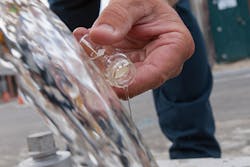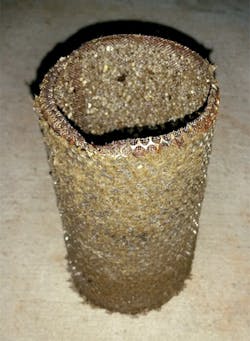Moving beyond the basics of process coolant filtration
Anyone who has ever had to clean a clogged heat exchanger fully understands the need to keep coolant contamination out of the process stream. Making that happen almost always depends on implementing a series of increasingly effective filtration technologies between the coolant source and the final application.
The basics of process coolant filtration
A system sourcing cooling water from a river or the ocean, for example, will typically include intake bars to block floating debris; a 3/8-inch to 3/4-inch screen; a 1/32-inch strainer and a filter to trap particles larger than 25 microns. Once it is in the process loop, the water will probably be filtered again before it is recycled to remove scale and other contaminants originating in the piping and process equipment.
- The engineers designing that filtration system have to consider a number of factors including, but not limited to:
- The water and/or fluid source
- The source, volume and nature of likely
contaminants - Heat exchanger materials and technology
- Process pressures and temperatures
- Acceptable downtime, if any, for filter
maintenance - Capital and long-term operating cost
It is obvious that no one-size-fits-all prepackaged solution is likely to be successful in such an environment. The reality is that engineering a filtration strategy for process cooling fluids can be every bit as challenging as developing a filtration solution for the process products themselves.
To begin with, the water source and the contaminants it is likely to contain will influence the type of media used in a strainer or filter. Sand, for example, is easily trapped in a porous filter medium because it does not change size or shape. On the other hand, an organic contaminant like pond scum is an entirely different challenge that is best handled with mechanically cleanable media.
Rain is a complicating factor that contaminates surface water with a broad range of organic and inorganic contaminants. Each of these presents a different challenge that has to be quantified and accommodated based on specific local conditions.
Once the water is in the system it is probably going to be chemically treated to reduce corrosion in piping and heat exchangers. Depending on the application, it may be filtered again to remove particulates under 25 microns that made it through the primary filtration system.
In any case, clean, treated process water represents a significant investment; that is why it almost certainly will be recycled through a secondary heat exchanger and recirculated through the process system. To protect that investment, and the equipment it interacts with, the water should be filtered once again to remove any particulates it has picked up from piping, heat exchangers or other process equipment.
Except for the initial removal of coarse contaminants, the water will be processed with a combination of strainers and filters. Both perform essentially the same function, but filters remove much smaller particles than strainers.
"If you can see it, you can strain it, otherwise use a filter" is a common rule of thumb. In practice, it means that particles in the range of 0.003 inch to 0.004 inch (0.07 to 0.1mm, 75 to 100 microns, 200 to 150 mesh) can be removed effectively with a strainer, and anything smaller, including particles down to a few microns, will require a filter.
Both strainers and filters require periodic cleaning to remove the buildup of particles trapped in the media. In a basic system using a simple basket-type strainer or a bag-type filter, maintenance can be as simple as shutting off the flow, manually removing the basket and dumping the trapped debris.
Obviously, that means the process is either shut down during strainer and/or filter maintenance or it is unprotected while the filter or strainer is bypassed. Neither situation is optimal.
And beyond
It is important to recognize that either a strainer or a filter creates a pressure drop and a flow restriction, and both factors must be accounted for in the system design. Adding either as an afterthought may require upsizing pumps and other system components to maintain adequate flow volume and pressure. Both system performance and long-term operating costs can be optimized by doing it right the first time with a filtration solution that goes beyond the basics.
In many, if not most, applications, the optimal solution is a self-cleaning strainer and/or filter that eliminates the need to take the filter offline to remove accumulated debris (which significantly extends the need for routine maintenance). This solution comes in two basic designs: automatic self-cleaning filter and mechanical self-cleaning filter.
An automatic self-cleaning filter uses a rotating hollow internal arm to collect debris deposited on the filter media. As the trapped particulates accumulate on the media, the pressure drop across the filter increases until a predetermined value is reached at which point a valve is opened to allow fluid and the accumulated debris to exit the filter through the hollow arm.
This type of filter is typically used in high-volume situations where fluid losses up to 5 percent of total flow during cleaning are acceptable. An automatic self-cleaning filter typically removes particles larger than 50 microns and can handle debris loads up to about 200 parts per million.
The second design option is a mechanical self-cleaning filter that uses a mechanical disc to scrape accumulated debris off the filter media. Like the automatic self-cleaning filter, the pressure drop is monitored as debris builds up on the media to actuate the cleaning disc at a predetermined value.
In this type of filter, the debris is deposited at the bottom of the filter housing where it can be removed without interrupting the flow through the filter. Mechanical self-cleaning filters are able to remove particles less than 10 microns in diameter and can handle higher debris loads up to about 500 parts per million and more frequent purge cycles than automatic filters. They also consume a much smaller volume of fluid during cleaning than an automatic filter.
Where finer filtration is required, system designers will have to consider other options like cartridge filters. These can be installed in multiple filter housing configurations that allow cartridges to be changed without interrupting the process flow. This approach can greatly reduce process downtime as less frequent maintenance is required compared to bag filtration solutions. The cost of purchasing and disposing of filter cartridges also has to be considered.
It should be clear by now that choosing an optimal process cooling filtration solution is not a simple process. Nevertheless, a worked example of a successful application will help demonstrate why it is well worth the time and effort.
Traditional strainers that protect process chillers can become clogged with debris. Image courtesy of Eaton Corporation
Why bother?
Biological buffers are key ingredients in many prescription medications and common over-the-counter drugs like aspirin, and process chilling is a key element in their production. During a recent upgrade of its facilities, one of the nation’s largest producers replaced old, inefficient chillers that experienced frequent breakdowns and had become too difficult to repair.
They replaced the old chillers with modern plate and frame heat exchangers. These were more efficient but also more prone to contamination and clogging in hard-to-clean areas, which quickly resulted in frequent process shut downs.
This initial solution was to schedule a weekly cleaning by a specialized contractor that required the entire system to be shut down for four to five hours. Even then, high production cycles introduced additional contaminants into the process cooling water that resulted in repeated calls to the contractor for costly unscheduled emergency cleanings.
Faced with unacceptable downtime and costs, plant officials contacted their Eaton distributor to determine if a self-cleaning filtration solution could effectively filter contaminants out and prevent their new chillers from clogging and interrupting the process. What they asked for was a solution that continuously cleaned itself so they did not have to constantly monitor the process and shut it down for manual cleaning.
Eaton Regional Sales Manager Jim Lago reviewed the operation and the customer’s needs and goals before recommending a pair of mechanical self-cleaning MCS-500 filters. These filters have a small footprint that allowed them to be installed in a tight space on the second floor of the plant. Lago also recommended a higher 30-micron level of filtration instead of the 60-micron filters that were currently installed.
The recommended filters are designed to handle fresh water from treated sources and are specifically designed to meet water filtration challenges in industrial manufacturing applications. They feature a magnetically coupled actuation system that eliminates the need for dynamic seals, provides easy maintenance access, reduces potential leaks and eliminates many moving parts to extend the filter’s service life.
The customer’s new filters were installed upstream of the chillers to filter 100 percent of the water flowing through them, which means contaminants are filtered out of the water source before they come into the process. To date, the filters have eliminated the need for regular weekly cleaning, its associated cost and downtime and the unscheduled downtime for emergency cleaning.
Now, biological buffer production is flowing without interruption, and the customer is convinced that moving beyond the basics of process coolant filtration to choose the right technology solution pays big dividends in the long run.
Vincent Amarosa, P.E., is industrial engineering manager at Eaton Corporation, Filtration Division, Tinton Falls, New Jersey.



